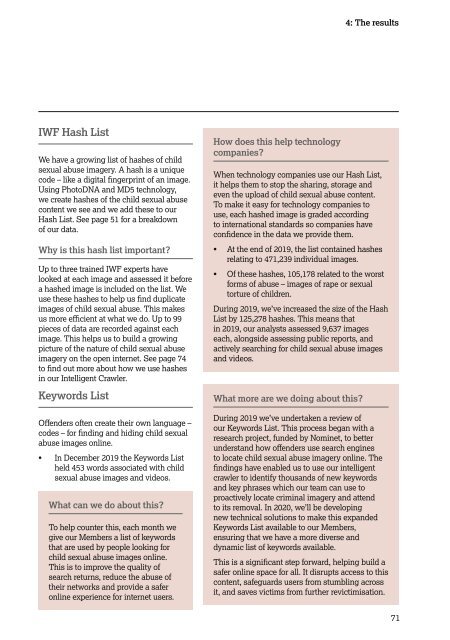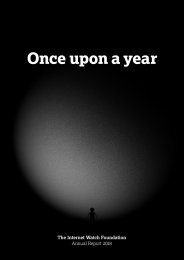Create successful ePaper yourself
Turn your PDF publications into a flip-book with our unique Google optimized e-Paper software.
4: The results<br />
<strong>IWF</strong> Hash List<br />
We have a growing list of hashes of child<br />
sexual abuse imagery. A hash is a unique<br />
code – like a digital fingerprint of an image.<br />
Using PhotoDNA and MD5 technology,<br />
we create hashes of the child sexual abuse<br />
content we see and we add these to our<br />
Hash List. See page 51 for a breakdown<br />
of our data.<br />
Why is this hash list important?<br />
Up to three trained <strong>IWF</strong> experts have<br />
looked at each image and assessed it before<br />
a hashed image is included on the list. We<br />
use these hashes to help us find duplicate<br />
images of child sexual abuse. This makes<br />
us more efficient at what we do. Up to 99<br />
pieces of data are recorded against each<br />
image. This helps us to build a growing<br />
picture of the nature of child sexual abuse<br />
imagery on the open internet. See page 74<br />
to find out more about how we use hashes<br />
in our Intelligent Crawler.<br />
Keywords List<br />
Offenders often create their own language –<br />
codes – for finding and hiding child sexual<br />
abuse images online.<br />
• In December <strong>2019</strong> the Keywords List<br />
held 453 words associated with child<br />
sexual abuse images and videos.<br />
What can we do about this?<br />
To help counter this, each month we<br />
give our Members a list of keywords<br />
that are used by people looking for<br />
child sexual abuse images online.<br />
This is to improve the quality of<br />
search returns, reduce the abuse of<br />
their networks and provide a safer<br />
online experience for internet users.<br />
How does this help technology<br />
companies?<br />
When technology companies use our Hash List,<br />
it helps them to stop the sharing, storage and<br />
even the upload of child sexual abuse content.<br />
To make it easy for technology companies to<br />
use, each hashed image is graded according<br />
to international standards so companies have<br />
confidence in the data we provide them.<br />
• At the end of <strong>2019</strong>, the list contained hashes<br />
relating to 471,239 individual images.<br />
• Of these hashes, 105,178 related to the worst<br />
forms of abuse – images of rape or sexual<br />
torture of children.<br />
During <strong>2019</strong>, we’ve increased the size of the Hash<br />
List by 125,278 hashes. This means that<br />
in <strong>2019</strong>, our analysts assessed 9,637 images<br />
each, alongside assessing public reports, and<br />
actively searching for child sexual abuse images<br />
and videos.<br />
What more are we doing about this?<br />
During <strong>2019</strong> we’ve undertaken a review of<br />
our Keywords List. This process began with a<br />
research project, funded by Nominet, to better<br />
understand how offenders use search engines<br />
to locate child sexual abuse imagery online. The<br />
findings have enabled us to use our intelligent<br />
crawler to identify thousands of new keywords<br />
and key phrases which our team can use to<br />
proactively locate criminal imagery and attend<br />
to its removal. In 2020, we’ll be developing<br />
new technical solutions to make this expanded<br />
Keywords List available to our Members,<br />
ensuring that we have a more diverse and<br />
dynamic list of keywords available.<br />
This is a significant step forward, helping build a<br />
safer online space for all. It disrupts access to this<br />
content, safeguards users from stumbling across<br />
it, and saves victims from further revictimisation.<br />
71




